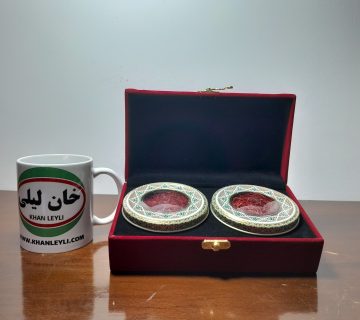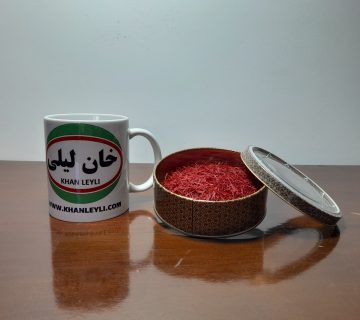Saffron is a spice derived from the flower of Crocus sativus, commonly known as the saffron crocus. The spice is obtained from the stigma (the female reproductive part) of the flower. Each saffron crocus flower produces three red stigmas, which are carefully hand-harvested and dried to create saffron threads.
Saffron is renowned for its distinct flavor, vibrant color, and unique aroma. It has been used for culinary, medicinal, and cosmetic purposes for centuries. The spice imparts a rich, earthy taste with subtle floral notes to dishes, and its vivid golden color enhances the visual appeal of food.
The cultivation of saffron is labor-intensive, as it requires a large number of flowers to yield a small quantity of the spice. Saffron is primarily cultivated in specific regions with the right climate and soil conditions, such as Iran, India, Spain, and Greece.
Beyond its culinary uses, saffron has historical significance in various cultures and is associated with traditional medicine. The spice contains compounds such as crocin and crocetin, which contribute to its unique properties, including antioxidant and potential mood-enhancing effects.
Due to its labor-intensive cultivation, limited geographic growth, and unique characteristics, saffron is considered one of the most expensive spices in the world. It remains a highly prized ingredient in gourmet cuisine and continues to be a symbol of luxury and refinement.
Saffron: The History of Saffron
Saffron, often referred to as the “Red Gold” or the “King of Spices,” boasts a rich and captivating history that dates back thousands of years. Originating from the flower Crocus sativus, saffron has not only flavored cuisines across cultures but also played a significant role in ancient rituals, medicine, and commerce.
Ancient Beginnings:
The story of saffron begins in ancient Mesopotamia, where it was initially cultivated for its unique and vibrant attributes. Sumerians and Egyptians recognized its value, incorporating saffron into culinary dishes, perfumes, and even as an offering to their deities.
Saffron in Antiquity:
As trade routes expanded, saffron found its way to ancient Greece and Rome, becoming a symbol of wealth and luxury. Greeks used saffron in perfumes, while Romans employed it as a precious seasoning and in the dyeing of fabrics. Its use in these ancient civilizations elevated saffron to a spice of distinction and opulence.
Medieval Spice Routes:
During the Middle Ages, saffron’s popularity continued to grow, and it became a highly sought-after commodity along the spice routes. Traders exchanged saffron as a valuable spice, connecting the East and West. This period marked saffron as not only a culinary delight but also a symbol of prosperity.
Renaissance and Beyond:
The Renaissance witnessed a resurgence of interest in saffron, particularly in Europe, where it was cultivated in regions such as Spain. Its distinctive flavor and color contributed to its allure, and saffron became a staple in the kitchens of the elite.
Saffron in Traditional Medicine:
Beyond its culinary uses, saffron has a history deeply intertwined with traditional medicine. Ancient cultures believed in its medicinal properties, using saffron to treat various ailments. Modern research continues to explore potential health benefits, such as antioxidant and mood-enhancing effects.
Modern Production:
Today, saffron is primarily cultivated in regions like Iran, India, and Spain. The cultivation process remains labor-intensive, requiring skilled hands to delicately harvest the precious crimson threads. Saffron’s reputation as the world’s most expensive spice persists, owing to its scarcity and the meticulous effort invested in its production.
Culinary Icon:
In the contemporary culinary world, saffron has transcended its historical roots, becoming a versatile and cherished ingredient. Its presence in diverse cuisines, from Indian biryanis to Spanish paellas, underscores its enduring global appeal.
In conclusion, the history of saffron is a tapestry woven with threads of ancient traditions, cultural significance, and culinary prestige. From its mystical origins in the cradle of civilization to its esteemed status today, saffron continues to captivate the world, embodying the essence of time-honored luxury and sophistication.
Cultivating Excellence: The Art and Science of Producing First-Class Saffron
Producing first-class saffron requires careful attention to various factors, from cultivation to harvesting and processing. Here are key steps to produce high-quality saffron:
- Selecting the Right Crocus sativus Variety:
– Choose a saffron crocus variety that is well-suited to your climate and soil conditions.
– Common varieties include “Pushal,” “Sargol,” and “Negin,” each with unique characteristics.
- Optimal Growing Conditions:
– Ensure the soil has good drainage to prevent waterlogging, as saffron bulbs are susceptible to rot.
– Plant the bulbs in a sunny location, as saffron thrives in well-lit areas.
– Monitor and maintain the appropriate pH level for the soil.
- Planting and Harvesting:
– Plant saffron corms (bulbs) in late spring or early summer.
– Allow the plants to establish for a year before harvesting any saffron.
– Harvest saffron threads during the flowering season by carefully plucking the red stigmas from each flower.
- Harvesting Techniques:
– Harvest saffron threads early in the morning when the flowers have just opened.
– Handle the delicate threads with care to avoid damage.
– Use skilled labor for hand-harvesting, as mechanical harvesting can damage the delicate saffron threads.
- Drying and Processing:
– Dry the harvested saffron threads immediately after harvesting to preserve their quality.
– Use a cool, dry, and well-ventilated area for drying.
– Avoid exposure to direct sunlight during the drying process.
– Once dried, store saffron in airtight containers in a cool, dark place.
- Quality Control:
– Implement rigorous quality control measures throughout the cultivation and processing stages.
– Regularly test the saffron for purity, color, flavor, and aroma.
– Ensure that saffron is free from contaminants or adulteration.
- Certifications and Traceability:
– Consider obtaining certifications for organic or high-quality saffron.
– Implement traceability measures to identify the origin of the saffron and provide transparency to consumers.
- Invest in Research and Development:
– Stay informed about the latest research and best practices in saffron cultivation.
– Invest in ongoing research and development to enhance cultivation techniques and overall quality.
- Environmental Considerations:
– Implement sustainable and environmentally friendly practices in saffron cultivation.
– Consider organic farming methods to attract environmentally conscious consumers.
By paying meticulous attention to each of these steps, saffron producers can increase the likelihood of producing first-class saffron that meets the highest quality standards and satisfies the discerning tastes of consumers.
Benefits of saffron: antidepressant properties
Saffron has been studied for its potential antidepressant properties, and several mechanisms may contribute to its mood-enhancing effects. The active components in saffron, including crocin, crocetin, and safranal, are believed to play a role in its antidepressant effects. Here are some of the ways in which saffron may exhibit antidepressant properties:
- **Serotonin Modulation:**
Saffron has been found to modulate the levels of serotonin in the brain. Serotonin is a neurotransmitter associated with mood regulation, and imbalances in serotonin levels are often linked to depression. Saffron’s influence on serotonin may contribute to its antidepressant effects.
- **Neurotransmitter Regulation:**
Saffron compounds, particularly crocin and crocetin, may impact the regulation of various neurotransmitters, including dopamine and norepinephrine. These neurotransmitters play essential roles in mood, and their dysregulation is implicated in depressive disorders.
- **Anti-Inflammatory Effects:**
Chronic inflammation has been associated with the development of depression. Saffron possesses anti-inflammatory properties, and its ability to reduce inflammation in the brain may contribute to its antidepressant effects.
- **Antioxidant Activity:**
Saffron is rich in antioxidants, which help protect cells from oxidative stress. Oxidative stress is linked to various mental health conditions, including depression. The antioxidant properties of saffron may contribute to a neuroprotective effect.
- **Neurogenesis Stimulation:**
Some studies suggest that saffron may stimulate neurogenesis, the process of generating new neurons in the brain. This is an area of ongoing research, and the potential role of saffron in promoting the growth of new neurons could have implications for mood regulation and mental health.
It’s important to note that while research on saffron’s antidepressant properties is promising, more studies are needed to fully understand the mechanisms and establish its efficacy. Additionally, individuals experiencing depression should consult with a healthcare professional for appropriate diagnosis and treatment, as saffron should not be used as a substitute for standard medical care.
Benefits of saffron: Hair loss straw
Saffron is believed to have several properties that may contribute to reducing hair loss and promoting overall hair health. While scientific research on saffron’s specific effects on hair loss is limited, traditional and anecdotal evidence suggests the following potential properties:
- Antioxidant Activity:
Saffron is rich in antioxidants, which help protect hair follicles from oxidative stress. Antioxidants play a role in neutralizing free radicals that can damage hair cells and contribute to hair loss.
- Anti-Inflammatory Effects:
Chronic inflammation can be a contributing factor to hair loss. Saffron’s anti-inflammatory properties may help reduce inflammation in the scalp, promoting a healthier environment for hair growth.
- Improved Blood Circulation:
Saffron may enhance blood circulation, including in the scalp. Improved blood flow to the hair follicles ensures better delivery of nutrients and oxygen, which is essential for healthy hair growth.
- Nutrient Content:
Saffron contains various vitamins and minerals, including vitamin A, vitamin C, and potassium. These nutrients are important for maintaining the health of the hair and may contribute to reducing hair loss.
- Saffron Oil for Scalp Massage:
Saffron oil, when used in combination with a carrier oil like olive or coconut oil, can be applied to the scalp for a massage. This may help nourish the scalp, strengthen hair follicles, and improve the overall condition of the hair.
- DHT Inhibition:
Some studies suggest that saffron may inhibit the production of dihydrotestosterone (DHT), a hormone linked to hair loss, especially in conditions like androgenetic alopecia. However, more research is needed to establish this effect conclusively.
It’s important to note that while saffron may offer potential benefits for hair health, individual responses can vary. If you’re experiencing significant hair loss or other scalp issues, it’s advisable to consult with a healthcare professional or a dermatologist for a thorough evaluation and appropriate guidance. They can help determine the underlying causes of hair loss and recommend suitable treatments.
Benefits of saffron: reducing body pain
Saffron has been traditionally used for its potential analgesic (pain-relieving) properties. While more research is needed to fully understand the mechanisms and effectiveness, some properties of saffron that may contribute to pain reduction include:
- Antioxidant and Anti-Inflammatory Effects:
Saffron contains compounds with antioxidant and anti-inflammatory properties. Chronic inflammation is often associated with pain, and saffron’s ability to reduce inflammation may contribute to its analgesic effects.
- Modulation of Neurotransmitters:
Some studies suggest that saffron may influence neurotransmitters in the brain, including serotonin. Serotonin plays a role in mood regulation and pain perception, and saffron’s impact on these neurotransmitters may contribute to its potential analgesic properties.
- Endorphin Release:
Saffron may stimulate the release of endorphins, which are natural pain-relieving compounds produced by the body. Endorphins can act as natural analgesics, reducing the perception of pain.
- Nervous System Modulation:
Saffron has been studied for its potential effects on the nervous system. It may modulate certain receptors and channels involved in pain sensation, influencing the way the body perceives and responds to pain signals.
- Crocetin Content:
Crocetin, a compound found in saffron, has been studied for its potential analgesic effects. It may have a role in reducing pain sensitivity.
It’s important to note that while saffron shows promise in preclinical and some clinical studies for its analgesic potential, more research is needed to establish its efficacy and safety conclusively. Moreover, individual responses to saffron can vary.
If you are experiencing persistent or severe pain, it is crucial to consult with a healthcare professional for a proper diagnosis and appropriate pain management. While saffron may complement overall health, it should not be used as a sole treatment for significant pain conditions without guidance from a medical professional.
Saffron in Bulk: A Cost-Effective and Convenient Choice
Buying bulk saffron can offer several benefits, especially for those who use saffron frequently or in larger quantities. Here are some advantages of purchasing saffron in bulk:
- Cost Savings:
Buying saffron in bulk often results in a lower cost per unit compared to purchasing smaller quantities. Saffron is known for being a premium and relatively expensive spice, so buying in bulk can lead to significant cost savings in the long run.
- Extended Supply:
A bulk purchase ensures a more extended supply of saffron, reducing the frequency of reordering. This is particularly beneficial for individuals or businesses that use saffron regularly in culinary or commercial applications.
- Convenience:
Having a substantial quantity of saffron on hand can be convenient for both home cooks and businesses. It eliminates the need for frequent trips to purchase saffron and ensures that it’s readily available when needed.
- Quality Assurance:
When buying in bulk from reputable suppliers, there’s often a better chance of ensuring the quality and authenticity of the saffron. Reputable bulk suppliers are likely to provide detailed information about the saffron’s origin, grade, and quality.
- Bulk Packaging Options:
Bulk saffron is typically available in various packaging options, such as vacuum-sealed bags or airtight containers. Proper packaging helps maintain the freshness and quality of saffron over an extended period.
- Customizable Packaging:
Some bulk suppliers may offer customizable packaging options, allowing customers to choose the quantity that best suits their needs. This flexibility is beneficial for both personal and commercial users.
- Reduced Environmental Impact:
Buying in bulk can contribute to reducing packaging waste, as larger quantities often require less overall packaging material per unit of saffron. This aligns with eco-friendly practices and reduces environmental impact.
- Bulk Discounts:
Many bulk suppliers offer discounts or wholesale pricing for larger quantities, providing additional cost savings for customers making bulk purchases.
When buying saffron in bulk, it’s crucial to choose a reputable supplier known for providing high-quality saffron. Check for information on saffron grade, origin, and purity to ensure that you are getting a product that meets your expectations.








No comment